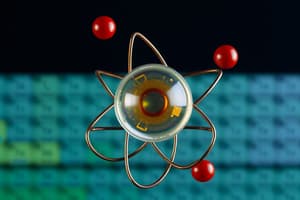Podcast
Questions and Answers
What characteristic is used to organize elements in the periodic table?
What characteristic is used to organize elements in the periodic table?
- Number of neutrons
- Number of electrons
- Atomic number (correct)
- Atomic mass
Which group of elements is known as the halogens?
Which group of elements is known as the halogens?
- Group 1
- Group 2
- Group 18
- Group 17 (correct)
If an element has an atomic number of 16 and an atomic mass of 32, how many neutrons does it have?
If an element has an atomic number of 16 and an atomic mass of 32, how many neutrons does it have?
- 12
- 48
- 16 (correct)
- 32
What does the valence shell of an atom refer to?
What does the valence shell of an atom refer to?
Which element is classified as a metalloid with properties of both metals and non-metals?
Which element is classified as a metalloid with properties of both metals and non-metals?
How many electrons can the second shell of an atom hold?
How many electrons can the second shell of an atom hold?
What is the correct Bohr-Rutherford diagram representation for Magnesium (atomic number 12)?
What is the correct Bohr-Rutherford diagram representation for Magnesium (atomic number 12)?
Which of the following is an alkali metal?
Which of the following is an alkali metal?
Flashcards
Periodic Table: Organization
Periodic Table: Organization
The periodic table organizes elements by increasing atomic number, aligning elements with similar properties in vertical columns called groups or families.
Alkali Metals
Alkali Metals
Group 1 elements are called alkali metals and are highly reactive, typically found in salts.
Metals on the Periodic Table
Metals on the Periodic Table
Elements on the left side of the periodic table generally have metallic properties, such as good conductors of heat and electricity.
Atomic Number
Atomic Number
Signup and view all the flashcards
Bohr-Rutherford Diagram
Bohr-Rutherford Diagram
Signup and view all the flashcards
Electron Shells
Electron Shells
Signup and view all the flashcards
Valence Shell
Valence Shell
Signup and view all the flashcards
Neutron Calculation
Neutron Calculation
Signup and view all the flashcards
Study Notes
Periodic Table
- Elements are arranged on the periodic table in order of atomic number (number of protons) from least to most
- Elements with similar properties are lined up vertically in groups or families
- Alkali metals (Group 1) include: lithium, sodium, potassium, rubidium, caesium
- Alkaline earth metals (Group 2) include: beryllium, magnesium, calcium, strontium, barium
- Halogens (Group 17) include: fluorine, chlorine, bromine, astatine, iodine, and tennessine
- Noble gases (Group 18) include: helium, neon, argon, krypton, xenon, radon
- Metals are on the left side of the periodic table
- Non-metals are on the right side of the periodic table
- Metalloids lie between the metals and non-metals and exhibit properties of both
- Silicone is a metalloid that is used in electronics as a switch that can conduct electricity like a metal or resist electricity flow like a non-metal
Periodic Table Cell Information
- Atomic number is in the top left corner and indicates the number of protons
- Chemical symbol is the big capital letter in the middle (second letter is lowercase)
- Chemical name is below the symbol
- Atomic mass is the bottom number (sum of protons and neutrons)
Bohr-Rutherford Diagrams
- The centre circle indicates the nucleus with the number of protons and neutrons
- Each subsequent circle is an electron shell that can hold a certain number of electrons
- The first shell holds a maximum of 2 electrons
- The second shell holds a maximum of 8 electrons
- The third shell holds a maximum of 8 electrons
- The outermost shell is called the valence shell
- The number of neutrons is calculated as the atomic mass minus the number of protons
Example Bohr-Rutherford Diagrams
-
Potassium (atomic number 19, atomic mass 39)
- 19 protons
- 19 electrons
- 20 neutrons
- Electron configuration: 2, 8, 8, 1 (valance shell has 1 electron)
-
Magnesium (atomic number 12, atomic mass 24)
- 12 protons
- 12 electrons
- 12 neutrons
- Electron configuration: 2, 8, 2 (valence shell has 2 electrons)
Studying That Suits You
Use AI to generate personalized quizzes and flashcards to suit your learning preferences.




